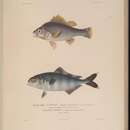Life Cycle
provided by Fishbase
Return to same river or lake site to spawn each year. Sexually segregated schools (uniform size & age-bet. 4-10 y) migrate upstream: female groups some days or weeks in advance. Most abundant in lakes fed by suitable shallow streams with rock or gravel substrates. Male nudges female vent region; eggs released, fertilized. Eggs turn transparent, increase to 4.0 mm diameter, are spherical, adhesive and demersal and are swept downstream lodging in boulders and pebbles. Hatching in 10-18 days (11-18°C). Larvae shelter in boulders.
Migration
provided by Fishbase
Potamodromous. Migrating within streams, migratory in rivers, e.g. Saliminus, Moxostoma, Labeo. Migrations should be cyclical and predictable and cover more than 100 km.
Morphology
provided by Fishbase
Dorsal spines (total): 8 - 12; Dorsal soft rays (total): 12 - 15; Analspines: 3; Analsoft rays: 8 - 11; Vertebrae: 28 - 31
Trophic Strategy
provided by Fishbase
Once widely distributed and abundant now restricted to temperate upper reaches of distribution range and in 1971 was considered a seriously threatened species. Siltation is the apparent cause of this decline. Juveniles are zooplanktivores, ingesting water fleas, rotifers and water mites with a sucking action. Peaceful community fish.
Biology
provided by Fishbase
Occurs in lakes and flowing streams usually in deep holes with rock or gravel substrates (Ref. 5259). Inhabits cool, clear water of rivers, lakes and reservoirs. Prefers slow-flowing, deep rocky pools. Solitary, swimming near the bottom or in mid-water, but form small shoals during the spawning season (October to December) (Ref. 44894). Forms large shoals near shore. Fry feeds on zooplankton; adult on aquatic insects, crustaceans and mollusks. Male matures at 20 cm (2 y), female at 30 cm (3 y). Spawns upstream in spring or early summer; eggs hatch in 13-18 days; larvae of 7 cm TL (Ref. 5259). Moves into areas just upstream of shallow riffles over gravel or rocky bottoms to spawn. The female releases demersal eggs which sink into cracks in the substrate. Fish in reservoirs move into flowing feeder streams to spawn. Sexual maturity is reached after 2 years (20 centimeters) for males, 3 years (30 centimeters) for females (Ref. 44894). Tolerates temp. down to 9°C (Ref. 7276). Infected by nematodes and copepod Lernaea cyprinacea (Ref. 7315).
Importance
provided by Fishbase
fisheries: commercial; aquaculture: commercial; gamefish: yes; aquarium: commercial

